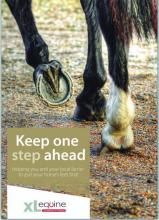The launch of the UK’s first campaign to bring together the farrier and vet to work as a team to help horse owners keep their horses’ sound was launched at World Horse Welfare’s Norfolk-based Hall Farm Rescue and Rehoming Centre in March 2015.
The collaborative campaign, ‘Keep one step ahead’, has been developed by members of the independent veterinary group, XLEquine, who have worked closely with World Horse Welfare to deliver the initiative.
Speaking at the launch, Dr Stuart Thorne MRCVS of XLEquine member practice, Fellowes Farm Equine Clinic, explained that although vets, farriers and horse owners each have a significant role in hoof healthcare, working together this becomes much stronger.
“The aim of the campaign is to promote close collaboration so that the horses in our care receive the best treatment.
“The old adage ‘No foot no horse’ remains as true as ever, however through owner education and farrier collaboration the aim of the campaign is to change this to ‘know foot, know horse’,” added Stuart.
The launch includes an information booklet for horse owners called ‘Keep one step ahead’. Member practices will also be running unique practical training workshops for horse owners as part of the XLEquine EquineSkills programme, as well as seminars and workshops for farriers.
Stuart highlighted the complex structure of the horse’s foot and went on to explain that at gallop, the thoroughbred puts double his 500 kilo weight through a structure that is less than 15cm in diameter, twice every second! “When you look at the impact on the foot during even regular exercise and jumping, it is quite incredible that it doesn’t break more often!” he added.
Chris Lehrbach MRCVS of XLEquine member practice, Chapelfield Veterinary Partnership, explained that the horse is not naturally designed to be ridden or to live and work on many of the surfaces we expect them to. “So many of the problems we see are due to their management and what we ask of them as horse owners and trainers.
“The list of conditions that make up the vast majority of lamenesses is extensive, but many of these can be avoided by careful management,” noted Chris.
“Advances in diagnostic imaging have been a real eye opener on the causes of lameness and has enabled vets and farriers to put this knowledge towards developing solutions, both remedial and preventative, that maximise equine welfare and positive outcomes.”
John Blake AWCF, of Breckland Farriers Ltd has been farrier to World Horse Welfare for nearly thirty years and has seen a huge range of conditions during that time: “As farriers we often need information from the vet – the more we get, the better judgement we can make. Technology advances are helping us greatly; I can get X-Rays sent over to my iPhone and to my client in an instant. However the key to good communication and collaboration is still to speak to people!”
John went on to talk about one of the most common conditions, laminitis. “With the exception of perhaps a broken limb, laminitis is one of the most painful conditions. The pain is often underestimated – it’s like pulling off half your fingernails then putting weight on them! As farriers we cannot diagnose, manage or treat acute pain from laminitis, this is for the vet and should be treated as an emergency,” he explained.
During his practical demonstration, John explained that modern farriery uses practical engineering solutions to create shoe designs for remedial work and correction. “As we learn more about the hoof, farriers are having to come up with engineering solutions that our predecessors were not able to,” he concluded.
Also launched at the event was an educational film by World Horse Welfare for horse owners, highlighting practical tips and information for horse owners. The charity has put hoof care at the forefront of a brand new educational initiative: a series of short, friendly and easy-to-follow online films aimed at owners who are diligent about good welfare practices. The clip is available at www.youtube.com/horsecharity
The booklet, ‘Keep one step ahead’ is available to all equine clients of XLEquine member practices, or it is available to view at http://www.xlequine.co.uk/campaigns/keep-one-step-ahead.



